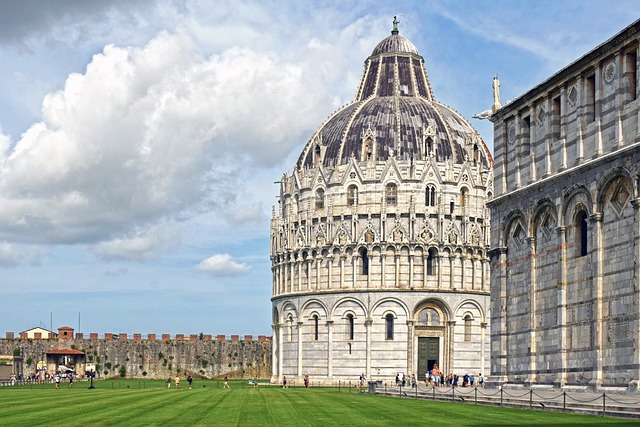A baptistery in the Catholic Church is a designated area within a church or separate building where the sacrament of baptism is administered. It is typically a large, centrally located space with a baptismal font for the immersion or pouring of water over the person being baptized. The baptistery is an important part of the church’s architecture and serves as a symbol of rebirth and initiation into the Christian faith.
Table of Contents
History of Baptistery in the Catholic Church
Have you ever heard the term “baptistery” in the Catholic Church and wondered what it means? Well, you’re not alone! Many people are unfamiliar with this term, but it actually has a rich history within the Catholic Church. In this article, we will explore the history of the baptistery in the Catholic Church and its significance in the sacrament of baptism.
The term “baptistery” comes from the Latin word “baptisterium,” which means a place for baptism. In the early days of the Catholic Church, baptisteries were separate buildings or structures specifically designed for the sacrament of baptism. These baptisteries were often located near the entrance of the church, symbolizing the entrance into the Christian faith through baptism.
The history of the baptistery in the Catholic Church dates back to the early centuries of Christianity. In the early Church, baptism was seen as a crucial sacrament for initiation into the Christian faith. As a result, baptisteries were built to accommodate the growing number of converts seeking baptism.
One of the most famous examples of a baptistery in the Catholic Church is the Baptistery of St. John in Florence, Italy. This baptistery is renowned for its stunning mosaics and its octagonal shape, symbolizing the eight days of creation and the resurrection of Christ on the eighth day. The Baptistery of St. John is a testament to the importance of baptism in the Catholic Church and the rich history of baptisteries in Christian tradition.
In addition to their architectural significance, baptisteries also played a crucial role in the sacrament of baptism. In the early Church, baptism was typically administered through immersion in water, symbolizing the washing away of sin and the rebirth into new life in Christ. Baptistries were designed with large baptismal fonts to accommodate this practice of immersion baptism.
As the centuries passed, the practice of immersion baptism gave way to other forms of baptism, such as pouring or sprinkling water over the head. Despite these changes, the baptistery remained an essential part of the Catholic Church, serving as a sacred space for the administration of the sacrament of baptism.
Today, many Catholic churches no longer have separate baptisteries, as the sacrament of baptism is often administered within the main church building. However, the tradition of the baptistery lives on in the architectural design of many churches, with baptismal fonts located near the entrance or at the front of the church.
In conclusion, the history of the baptistery in the Catholic Church is a testament to the importance of baptism in the Christian faith. While the practice of immersion baptism may have evolved over time, the baptistery remains a symbol of the sacrament of baptism and its significance in the life of the Church. So, the next time you hear the term “baptistery” in the Catholic Church, you’ll have a better understanding of its rich history and significance.
Significance of Baptistery in Catholic Church
Have you ever wondered what a baptistery is in the Catholic Church? If you’re unfamiliar with this term, don’t worry – you’re not alone. A baptistery is a special area within a church where the sacrament of baptism is performed. It is a sacred space where individuals are welcomed into the Christian faith through the ritual of baptism.
Baptism is a significant sacrament in the Catholic Church, as it is the first step in a person’s journey of faith. It is through baptism that individuals are cleansed of original sin and welcomed into the community of believers. The baptistery plays a crucial role in this process, as it is the physical location where the sacrament takes place.
The design of a baptistery can vary depending on the church’s architectural style and traditions. Some baptisteries are small, intimate spaces, while others are grand and elaborate. Regardless of their size, all baptisteries are designed to create a sense of reverence and awe, reflecting the sacred nature of the sacrament of baptism.
One of the key features of a baptistery is the baptismal font, which is a basin or pool of water used for the sacrament of baptism. The font is typically located at the center of the baptistery, symbolizing the centrality of baptism in the life of the Church. The water in the font is blessed by a priest before the sacrament takes place, signifying the cleansing and purifying power of baptism.
In addition to the baptismal font, many baptisteries also feature artwork and symbols that reflect the significance of baptism. These may include images of Christ’s baptism in the Jordan River, the descent of the Holy Spirit, or scenes from the Gospels that highlight the importance of baptism in the life of a Christian.
The baptistery is not only a place for the sacrament of baptism to take place, but it is also a place of welcome and hospitality. It is where individuals are embraced by the community of believers and invited to share in the life of the Church. The baptistery is a symbol of the Church’s mission to welcome all people into the family of God, regardless of their background or circumstances.
In many Catholic churches, the baptistery is located near the entrance, symbolizing the idea that baptism is the gateway to the Christian life. As individuals enter the church, they are reminded of their baptism and the call to live out their faith in the world. The baptistery serves as a constant reminder of the grace and mercy of God, inviting all who enter to experience the love of Christ in a tangible way.
In conclusion, the baptistery is a sacred space within the Catholic Church where the sacrament of baptism is performed. It is a place of welcome, hospitality, and transformation, where individuals are cleansed of sin and welcomed into the community of believers. The baptistery serves as a reminder of the centrality of baptism in the life of the Church and invites all who enter to experience the grace and love of God in a profound way.
Rituals and Traditions in Baptistery

Have you ever heard of a baptistery in the Catholic Church? If not, you’re not alone. Many people are unfamiliar with this term and what it represents in the context of Catholic rituals and traditions. In this article, we will explore the significance of the baptistery and its role in the Catholic Church.
The baptistery is a designated area within a church where the sacrament of baptism is performed. It is typically a separate space from the main worship area, often located near the entrance of the church. The baptistery is a sacred space where individuals are initiated into the Christian faith through the sacrament of baptism.
Baptism is a fundamental sacrament in the Catholic Church, as it is the first step in the process of becoming a member of the Church. Through baptism, individuals are cleansed of original sin and welcomed into the community of believers. The baptistery serves as the physical location where this spiritual rebirth takes place.
The design of the baptistery is often symbolic, reflecting the significance of the sacrament of baptism. Many baptisteries are circular in shape, representing the eternal nature of God’s love and the unity of the Church. The use of water in baptism symbolizes purification and new life, as individuals are washed clean of sin and born anew in Christ.
In addition to its symbolic significance, the baptistery also serves a practical purpose in the administration of the sacrament of baptism. The baptistery typically contains a baptismal font, a large basin of water used for the immersion or pouring of water over the individual being baptized. The baptismal font is often ornately decorated, reflecting the sacredness of the sacrament.
The ritual of baptism involves the pouring or immersion of water over the individual’s head, accompanied by the words “I baptize you in the name of the Father, and of the Son, and of the Holy Spirit.” This ritual symbolizes the individual’s incorporation into the life of the Church and their commitment to living out their faith as a follower of Christ.
The baptistery is also a place of community and celebration, as families and friends gather to witness and support those being baptized. It is a joyous occasion that marks the beginning of a new chapter in the individual’s spiritual journey. The baptistery serves as a reminder of the importance of community in the life of faith and the support that believers offer one another on their journey of discipleship.
In conclusion, the baptistery is a sacred space within the Catholic Church where the sacrament of baptism is performed. It is a place of initiation, purification, and new life, where individuals are welcomed into the community of believers and begin their journey of faith. The baptistery serves as a physical and symbolic reminder of the significance of baptism in the life of the Church and the individual believer.
Architectural Features of Baptistery in Catholic Church
Have you ever walked into a Catholic church and noticed a separate building or area designated as a baptistery? You may have wondered what exactly a baptistery is and why it is important in the Catholic Church. In this article, we will explore the architectural features of a baptistery in the Catholic Church and its significance in the sacrament of baptism.
A baptistery is a separate building or area within a church specifically designed for the sacrament of baptism. It is typically located near the entrance of the church, symbolizing the entrance into the Christian faith through the waters of baptism. The design of a baptistery can vary greatly depending on the time period and region in which it was built, but there are some common architectural features that can be found in many baptisteries.
One of the most distinctive features of a baptistery is the baptismal font, which is a large basin or pool used for the immersion or pouring of water during the sacrament of baptism. The baptismal font is often placed at the center of the baptistery, symbolizing the centrality of baptism in the life of a Christian. The font may be made of various materials such as marble, stone, or metal, and may be decorated with intricate carvings or designs.
In addition to the baptismal font, many baptisteries also feature artwork or mosaics depicting scenes from the life of Christ or the saints. These artistic elements serve to enhance the spiritual atmosphere of the baptistery and provide a visual representation of the Christian faith. Some baptisteries also have a dome or cupola overhead, symbolizing the heavens and the presence of God during the sacrament of baptism.
The layout of a baptistery is often circular or octagonal in shape, symbolizing the eternal nature of the sacrament of baptism and the unity of the Church. The circular or octagonal design also allows for a more intimate and communal experience during the baptismal ceremony, as the congregation can gather around the baptismal font to witness the sacrament taking place.
Transitional phrase: Now that we have explored the architectural features of a baptistery in the Catholic Church, let’s delve into the significance of the baptistery in the sacrament of baptism.
The baptistery plays a crucial role in the sacrament of baptism, which is one of the seven sacraments of the Catholic Church. Baptism is the sacrament through which a person is initiated into the Christian faith and becomes a member of the Church. It is a sacrament of initiation, along with Confirmation and Eucharist, that marks the beginning of a person’s journey of faith.
The baptistery serves as a sacred space where the sacrament of baptism is celebrated and where the community gathers to welcome new members into the Church. It is a place of prayer, reflection, and renewal, where the grace of God is poured out upon the baptized and where they are cleansed of sin and reborn in Christ.
In conclusion, the baptistery is a significant architectural feature in the Catholic Church that plays a central role in the sacrament of baptism. Its design and layout are meant to enhance the spiritual experience of the sacrament and to symbolize the eternal nature of baptism and the unity of the Church. The baptistery serves as a sacred space where the sacrament of baptism is celebrated and where new members are welcomed into the Christian faith.
Baptismal Font in Baptistery of Catholic Church
Have you ever wondered what a baptistery is in the Catholic Church? If you’re unfamiliar with this term, don’t worry – you’re not alone. A baptistery is a special area within a Catholic church where baptisms are performed. It is typically a separate room or designated space within the church that is specifically set aside for the sacrament of baptism.
The baptistery is an important part of the Catholic Church because baptism is one of the seven sacraments that Catholics believe are essential for salvation. Baptism is the sacrament of initiation into the Christian faith, and it is through baptism that individuals are cleansed of original sin and welcomed into the Church.
In the baptistery, you will often find a baptismal font, which is a basin or container used for the sacrament of baptism. The baptismal font is usually filled with holy water, which is blessed by a priest before the baptism takes place. The water in the font symbolizes the cleansing and purifying power of baptism, as well as the new life that comes from being baptized.
The baptismal font is typically placed at the center of the baptistery, symbolizing the importance of baptism in the life of the Church. It is often made of stone or marble, and may be decorated with intricate carvings or designs. Some baptismal fonts are even adorned with symbols of the Christian faith, such as crosses or images of saints.
When a baptism is performed in the baptistery, the priest or deacon will pour water over the head of the person being baptized, while saying the words of the baptismal formula: “I baptize you in the name of the Father, and of the Son, and of the Holy Spirit.” This ritual symbolizes the washing away of sin and the new life that comes from being baptized into the Christian faith.
After the baptism is complete, the newly baptized person is anointed with chrism oil, which is a sign of being sealed with the gift of the Holy Spirit. This anointing is a symbol of the person’s new identity as a member of the Church, and their commitment to living out their faith in their daily lives.
The baptistery is a sacred space within the Catholic Church, and it is a place where the sacrament of baptism is celebrated with reverence and joy. It is a reminder of the importance of baptism in the life of a Christian, and a symbol of the new life that comes from being baptized into the faith.
So, the next time you visit a Catholic church, take a moment to appreciate the beauty and significance of the baptistery. It is a place where the sacrament of baptism is celebrated, and where individuals are welcomed into the Church with open arms. It is a reminder of the power of baptism to cleanse and renew, and a symbol of the new life that comes from being baptized into the Christian faith.
Conclusion
A baptistery in the Catholic Church is a separate building or part of a church where the sacrament of baptism is administered. It is typically a place where individuals, usually infants, are baptized into the faith. The baptistery is often adorned with religious symbols and artwork, and serves as a sacred space for the initiation of new members into the Church.

